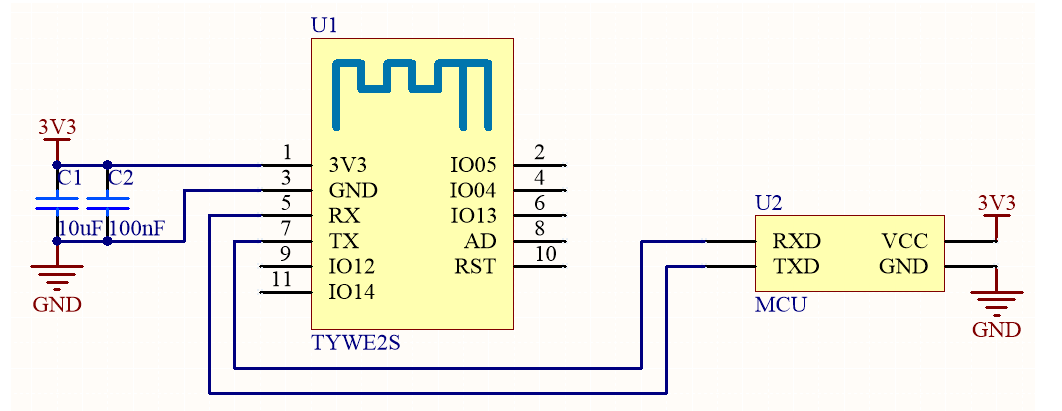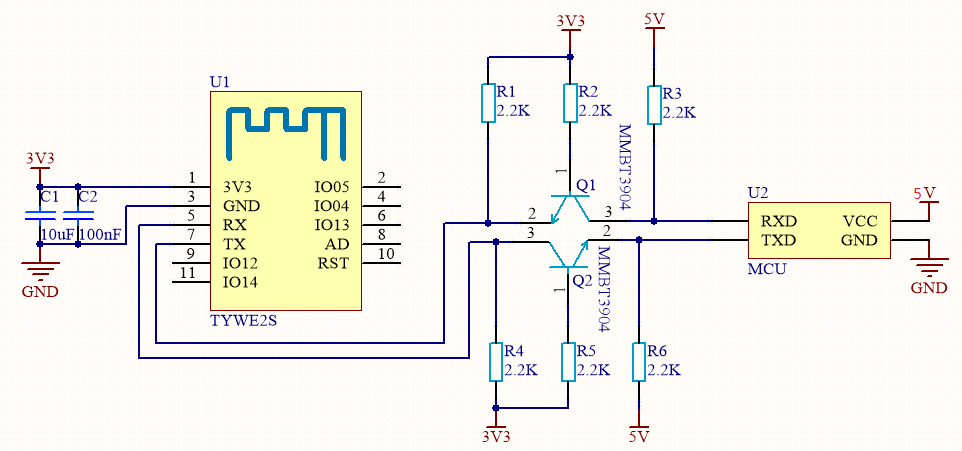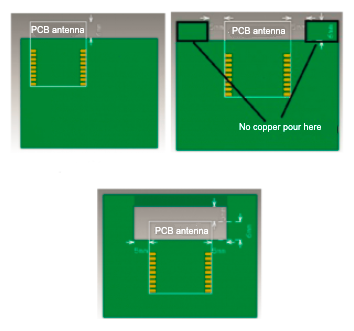TYWE2S Module
Last Updated on : 2024-06-24 05:57:35download
TYWE2S is a low power embedded Wi-Fi module developed by Tuya Smart.
Scope of application
This topic describes relevant information about TYWE2S module during MCU connection development.
TYWE2S is a low power embedded Wi-Fi module developed by Tuya Smart. The module consists of a highly integrated radio-frequency identification (RFID) chip ESP8285 and a few peripheral components, with a built-in Wi-Fi network protocol stack and various library functions. TYWE2S also has a low power 32-bit CPU, 1 MB flash, 50 KB static random access memory (SRAM), and rich peripheral resources. As a real time operating system (RTOS) platform, TYWE2S integrates all function libraries of Wi-Fi MAC and TCP/IP protocols. You can develop your own embedded Wi-Fi products.
For more information, see TYWE2S Module Datasheet.
Typical application diagram
-
Reference diagram of coordinated processing mode of the module and 3.3 V MCU:

-
Reference diagram of coordinated processing mode of the module and 5 V MCU:

Design specification
-
Module power supply:
- When the module is in the working mode, the maximum transient current reaches 451 mA. It is recommended that the supply current of the 3.3 V module should exceed 500 mA.
- In the PCB layout, capacitors C1 and C2 at the power input pin shall be arranged near the power supply pin. The capacitance shall exceed 10 uF.
-
Module pin:
- RST pin only resets the module hardware, but cannot clear Wi-Fi network configuration information. A power-on reset (POR) circuit is added inside the RST pin. Also, the module can be controlled by the general-purpose input-output (GPIO) port of MCU. Pay attention to electrical level conversion.
- AD pin can only be used as an ADC port, and cannot be used as an ordinary I/O port. When not in use, the pin can float. As the ADC input port, the input voltage ranges from 0 V to 1.0 V.
-
Radio frequency (RF) of the module:
- When a PCB onboard antenna is used in the Wi-Fi module, it is recommended that the distance between the module antenna and other metal parts should be at least 15 mm, in order to optimize the Wi-Fi performance. Wiring and copper pour are not allowed in the antenna area of the PCB, in order not to affect the antenna performance. Layout: make sure that no substrate medium exists directly below or above the printed antenna, and the printed antenna is away from the copper sheet. In this way, the antenna radiation effect is guaranteed to the maximum extent.

- When a PCB onboard antenna is used in the Wi-Fi module, it is recommended that the distance between the module antenna and other metal parts should be at least 15 mm, in order to optimize the Wi-Fi performance. Wiring and copper pour are not allowed in the antenna area of the PCB, in order not to affect the antenna performance. Layout: make sure that no substrate medium exists directly below or above the printed antenna, and the printed antenna is away from the copper sheet. In this way, the antenna radiation effect is guaranteed to the maximum extent.
Is this page helpful?
YesFeedbackIs this page helpful?
YesFeedback





